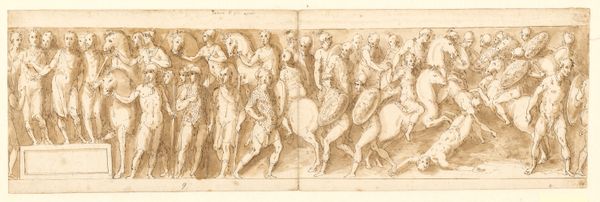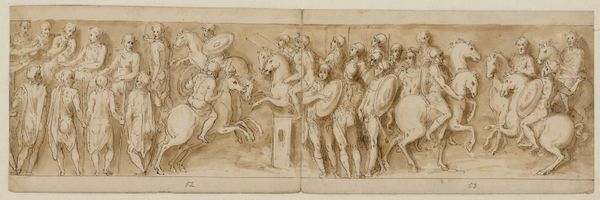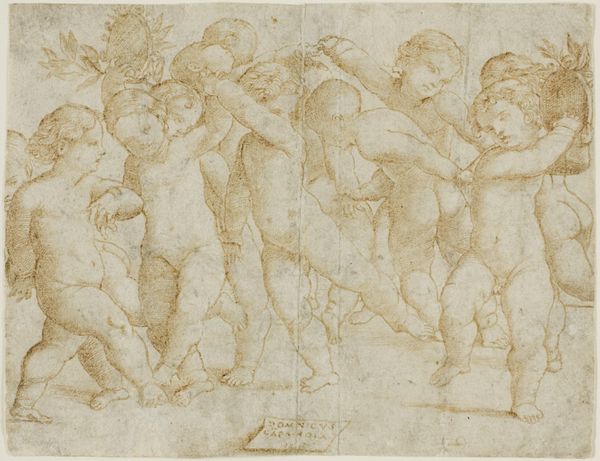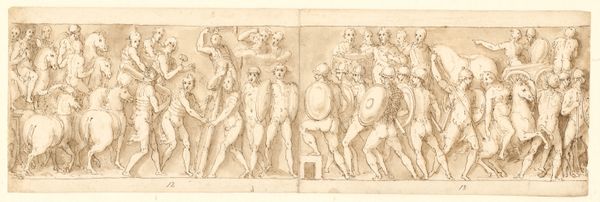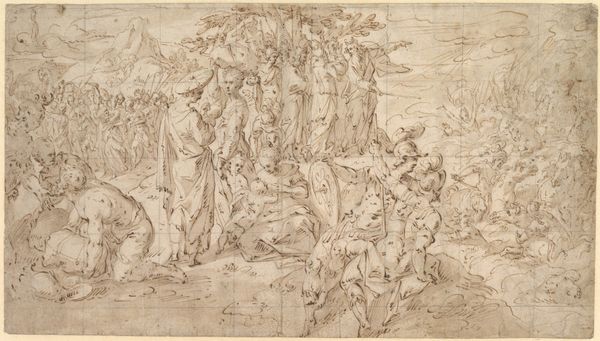
32 kopier efter Marcus Aurelius-søjlen, Piazza Colonna i Rom 1544 - 1618
0:00
0:00
drawing, pencil
#
drawing
#
narrative-art
#
pencil sketch
#
greek-and-roman-art
#
etching
#
figuration
#
ancient-mediterranean
#
pencil
#
history-painting
Dimensions: 133 mm (height) x 432 mm (width) (bladmaal)
Curator: Before us is a drawing titled "32 copies after Marcus Aurelius-column, Piazza Colonna in Rome." It was created by Giovanni Guerra between 1544 and 1618. Editor: Immediately, the sense of layering is overwhelming. Figures upon figures, chaotic action. The monochromatic medium reinforces the antiquity of the source material, while that incredible length just conveys so much information. Curator: Guerra made a total of 32 known sheets of drawings depicting the column of Marcus Aurelius. This pillar itself served as an important political symbol within Rome during its creation. Marcus Aurelius led multiple successful military campaigns, particularly the Marcomannic Wars in the late 2nd century AD, and the spiral of sculpted relief illustrates those very victories. Editor: That’s what strikes me, actually—the representation of Roman power as a continuous loop. Are we meant to be inspired or is there commentary here, the endlessness suggesting the crushing weight of empire on everyday lives and bodies? There is a certain terror when looking at scenes like these en masse because we, even as onlookers, have a different understanding about power structures in today's climate. Curator: Certainly the intent when creating the column was celebratory, although by Guerra’s time I imagine its symbolic function was evolving in complex ways. I think of this sketch and others within the series as acts of preservation; memory becomes material, echoing what the Roman pillar did, carrying narrative to new audiences. In his own right, he immortalizes already monumental narratives for centuries to come. Editor: Preservation is never neutral. Who gets to dictate which parts of history survive through representation? In viewing Guerra's work, consider who is being depicted, whose story matters, and what this preservation obscures. Curator: Such an observation brings to mind other ancient pillars erected across the globe and through different ages; as expressions of power but also records of cultural and historic shifts. I keep returning to its scale in my mind: a powerful echo to historical awareness, to the necessity to read through an original’s visual language and recognize their political nature as symbolic expressions of our civilizations. Editor: Yes, and that each figure in that epic frieze now carries its own emotional charge. It is like this drawing holds time and suffering in its marks. It invites viewers to contemplate the human cost of empire.
Comments
No comments
Be the first to comment and join the conversation on the ultimate creative platform.
